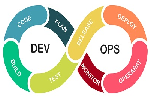Operating System
What is an Operating System?
An Operating system (OS) is a software which acts as an interface between the end user and computer hardware. Every computer must have at least one OS to run other programs. An application like Chrome, MS Word, Games, etc needs some environment in which it will run and perform its task. The OS helps you to communicate with the computer without knowing how to speak the computer's language. It is not possible for the user to use any computer or mobile device without having an operating system. Linux is one of popular version of UNIX operating System. It is open source as its source code is freely available. It is free to use. Linux was designed considering UNIX compatibility. Its functionality list is quite similar to that of UNIX.
COMPONENTS OF AN OPERATING SYSTEM
The different components of an operating system enable it to perform its duty of enabling the different parts of a computer to work together. Letís take a look at what each of these components does.
1. Kernel.
The kernel forms part of the building blocks to the work of an operating system. It helps in managing the hardware devices in the computer by determining the hardware resources that will get access to different programs. By doing this, it ensures that the CPU is operating optimally at all times.
2. Process Management.
There are very many programs running on a computer at any one time. From background applications to the programs that users are actively interacting with, there are hundreds of processes taking place in a computer during normal use. Since all modern operating systems allow multi-tasking, it is the operating systemís duty to distribute the available resources among all the active processes.
3. Memory Management.
There are several types on memory on a modern computer. They include CPU cache, RAM and disk storage. The operating system has a memory manager that tracks the amount of each memory thatís available and manages the movement of data between them. This ensures that the highest amount of available memory for each process so as to increase speed of execution. The operating system also ensures that whenever two or more processes are in memory at the same time, virtual memory addresses are allocated to each process to ensure that no process interferes with anotherís memory.
4. Security.
Since the operating system is in charge of directly or indirectly controlling computing resources, it should be able to distinguish between the requests that should be allowed and those that shouldnít. This includes internal requests from within the computer as well as external requests from other computers within the network. They also offer auditing options to tell the users that have accessed different files and any changes that may have been made. /h4>
5. Networking.
Networking basically enables operating systems to share resources using different types of connections. The most common networking protocol is the TCP/IP protocol.
6. File Systems and Disk Access.
Controlling access to data stored on the different disks in computers is a primary feature of operating systems. The operating system ensures that files are stored in a manner that allows quick access and the highest possible reliability. In addition, they also help make good use of the available space on the disk. The file system is the manner in which files are stored on a disk. It gives
The DevOps seminar will help you to learn DevOps from scracth to deep knowledge of various DevOps tools such as fallowing List.
Kubernetes.Learn Latest Technologies

DevOps

AWS

Python

Azure

G Cloud

Linux

Web Tech

Data Bases

Testing

Git

Ansible

Chef

Kubernetes

HTML

CSS

